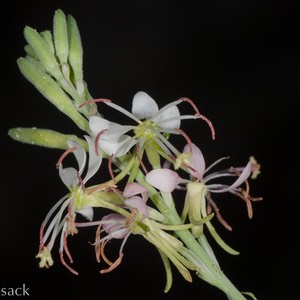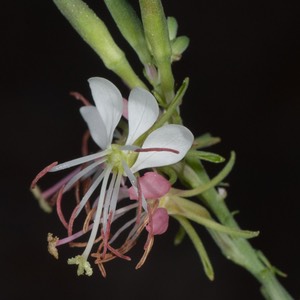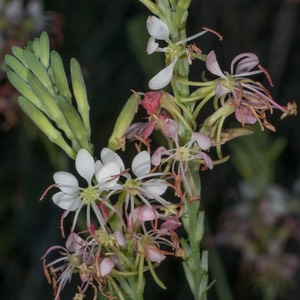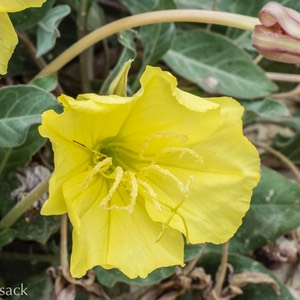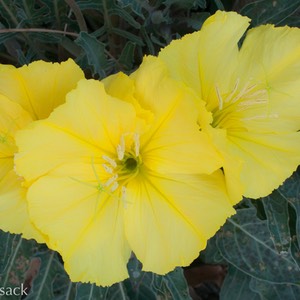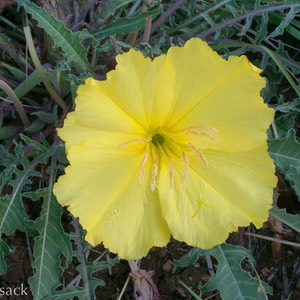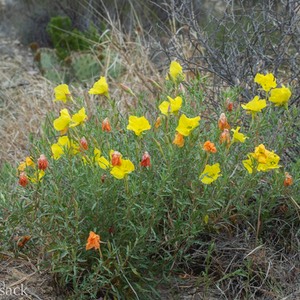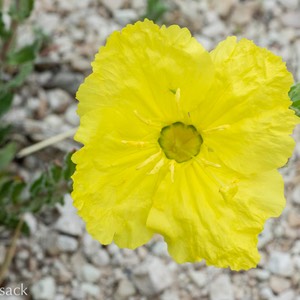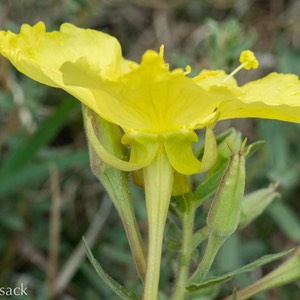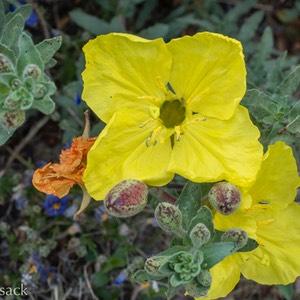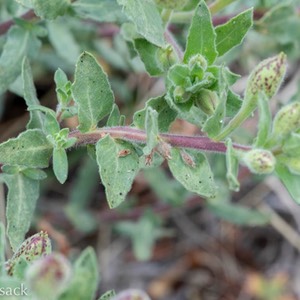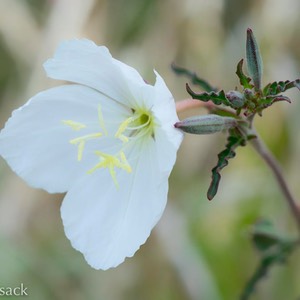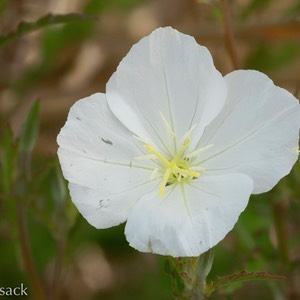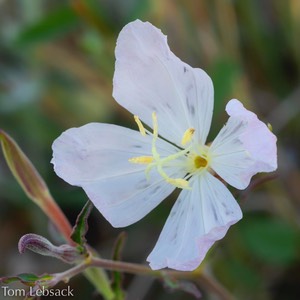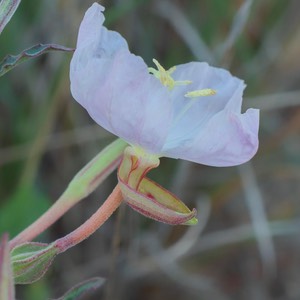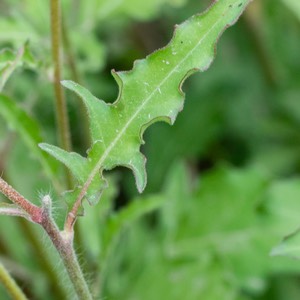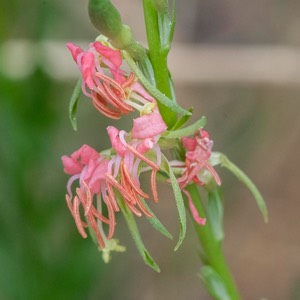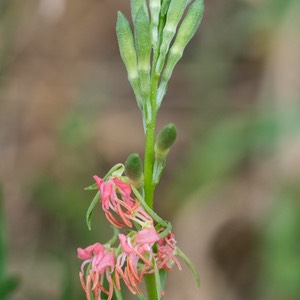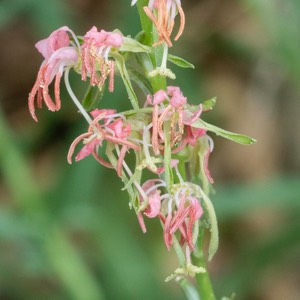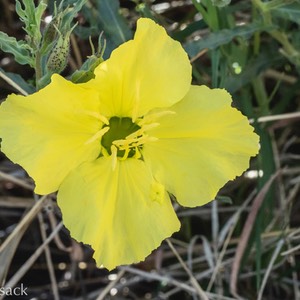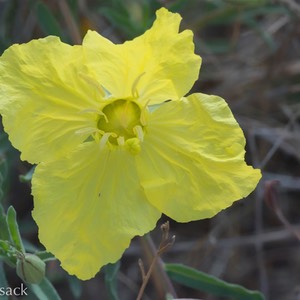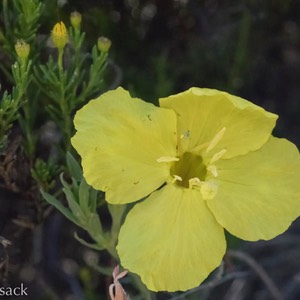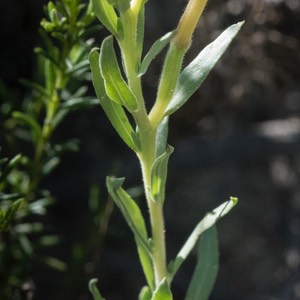Click on the images below to see larger versions.
| Scientific Name | Oenothera boquillensis (Gaura boquillensis) | USDA PLANTS Symbol |
|
| Common Name | Rio Grande Beeblossom, Boquillas Lizardtail | ITIS Taxonomic Serial No. |
|
| Family | Onagraceae (Evening Primrose) | SEINet Reference |
Click Here |
| Description |
Habitat: Sandy areas along canyon walls and slopes, and in gravelly arroyos; near the Rio Grande. Plant: Erect, clumped, multi-stemmed perennial, 10 to 40 inches tall. Leaves: Basal narrowly oblanceolate, upper narrowly elliptic to lanceolate or linear; 1/4 to 2-1/2 inches long and wavy, toothed edges. Inflorescence: Flowers in a congested, unbranched spike, 4 white-to-light pink (often fading to purplish) petals around the top half of the blossom, and 8 long stamens with pink anthers and long central stigma; green sepals below. Bloom Period: March to August. References: "Manual of the Vascular Plants of Texas" by Correll and Johnston, "Rare Plants of Texas" by Poole, Carr, Price and Singhurst and Smithsonian Museum of Natural History. |
BONAP Distribution Map |
Texas Status: Native |
| Scientific Name | Oenothera brachycarpa | USDA PLANTS Symbol | OEBR |
| Common Name | Short-fruit Evening Primrose | ITIS Taxonomic Serial No. | 27378 |
| Family | Onagraceae (Evening Primrose) | SEINet Reference |
Click Here |
| Description | Habitat: Dry rocky slopes, 4,000-7,000 ft. Plant: Erect, nearly stemless, short perennial, less than 12 inches tall. Leaves: Basal rosette, lanceolate or ovate-lanceolate-shaped with entire to sinuate-dentate margins, 1-1/4 to 6 inches long and 3/8 to 1-1/4 inches wide; with prominent central vein and petioles 3/8 to 2-3/8 inches long. Inflorescence: Large yellow flowers rising from axils of uppermost leaves, 4 inches wide; hypanthium (resembling a stem) 2 to 6 inches long; 4 yellow petals becoming orange-red in age. Bloom Period: March to July. References: "Manual of the Vascular Plants of Texas" by Correll and Johnston, "Wildflowers of Texas" by Michael Eason and SEINet. |
BONAP Distribution Map N/A |
Texas Status: Native |
| Scientific Name | Oenothera hartwegii (Calylophus hartwegii) | USDA PLANTS Symbol | CAHA14 |
| Common Name | Showy Evening Primrose | ITIS Taxonomic Serial No. | 517700 |
| Family | Onagraceae (Evening Primrose) | SEINet Reference |
Click Here |
| Description | Habitat: Sandy and limestone soils in various ecologies including deserts, plains, foothills and canyons. Plant: Bushy perennial herb from a woody caudex; stems woody near the base, ascending to almost erect, somewhat branched; 4 to 16 inches tall. Leaves: Alternate, sessile stem leaves with linear to oblong-lanceolate, 3/8 to 2 inches long and 3/16 to 3/8-inch wide; edges entire to denticulate; leaf surfaces smooth, hairy, or glandular-hairy. Inflorescence: Arising from the upper leaf axils, solitary, showy flowers 3/4 to 2+ inches across, with 4 yellow petals becoming reddish; 8 yellow stamens and prominent yellow stigma; 4 sepals reflexed beneath; floral tube 5/8 to 2-1/8 inches long; flower opens in the afternoon or near sunset. Bloom Period: March to October. References: "Manual of the Vascular Plants of Texas" by Correll and Johnston and SEINet. |
BONAP Distribution Map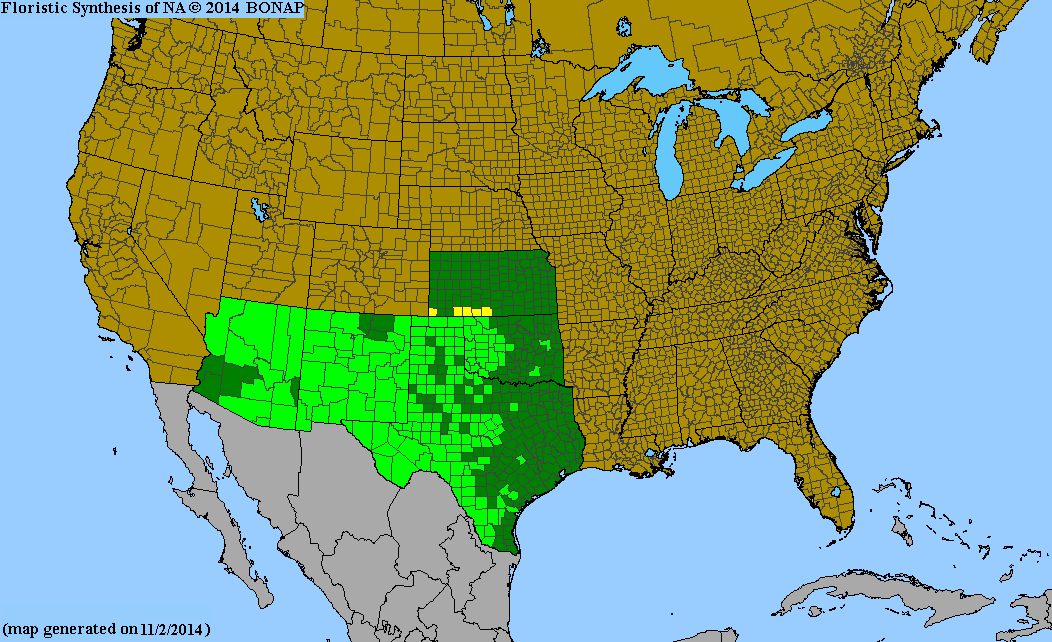 |
Texas Status: Native |
| Scientific Name | Oenothera kunthiana | USDA PLANTS Symbol |
|
| Common Name | Kunth's Evening Primrose | ITIS Taxonomic Serial No. |
|
| Family | Onagraceae (Evening Primrose) | SEINet Reference |
Click Here |
| Description |
Habitat: Gravel bars, sandy flats, washes, drainages, roadsides open grassy and brushy areas Plant: Erect annual branching from base, nearly smooth stems up to 16 inches tall. Leaves: Alternate stem leaves, lanceolate to oblanceolate in outline, margins pinnatifid, sinuate or entire, up to 3-3/4 inches long and 1 inch wide on petioles up to 3/4-inch long. Inflorescence: Solitary white flowers about 1-1/2 inches across inches wide opening near sunset; floral tube 3/8 to 3/4- inch long; sepals 1/4 to 3/4 inches long; 4 white petals fading to pink. Bloom Period: February to May. References: "Manual of the Vascular Plants of Texas" by Correll and Johnston, "Wildflowers of Texas" by Michael Eason and www.americansouthwest.net. |
BONAP Distribution Map |
Texas Status: Native |
| Scientific Name | Oenothera suffrutescens (Gaura coccinea) | USDA PLANTS Symbol | OESU3 |
| Common Name | Scarlet Gaura, Scarlet Beeblossom | ITIS Taxonomic Serial No. | 836008 |
| Family | Onagraceae (Evening Primrose) | SEINet Reference |
Click Here |
| Description |
Habitat: Sandy and calcareous soils in prairies, disturbed areas and a variety of environments; widespread in Texas. Plant: Erect, somewhat hairy multi-stemmed perennial, up to 40 inches tall. Leaves: Alternate, stalkless, narrow, linear to linear-oblanceolate leaves, 1/2 to 2-1/2 inches long, crowded along the stems; margins entire to somewhat dentate. Inflorescence: Densely-flowered terminal spike 2 to 6 inches long elongating with age, often lax or nodding at the tip; small flowers about 5/8-inch across; 4 sepals less than 1/4 to 3/8-inch long; 4 short, white to pink petals 1/4-inch long becoming red to dark-red with age; 8 stamens with long white filaments and red anthers. Bloom Period: April to July. References: Gaura coccinea in "Manual of the Vascular Plants of Texas" by Correll and Johnston, "Wildflowers of the Texas Hill Country" by Marshall Enquist and "Wildflowers of Texas" by Geyata Ajilvsgi; SEINet. |
BONAP Distribution Map |
Texas Status: Native |
| Scientific Name | Oenothera tubicula (Calypholus tubicula) | USDA PLANTS Symbol | CATU6 |
| Common Name | Texas Sundrops | ITIS Taxonomic Serial No. | 836081 |
| Family | Onagraceae (Evening Primrose) | SEINet Reference |
Click Here |
| Description | Habitat: Desert environment, gravelly, calcareous soils in dry washes and flats. Plant: Erect perennial, single or multiple stems, slightly hairy, do not appear to be woody, 4 to 12 inches tall; branched in upper part. Leaves: Narrowly lanceolate to lanceolate, alternate, somewhat hairy, nearly sessile, 1 to 2 inches long with smooth edges. Inflorescence: Yellow tubular blossoms opening 1 to 2 hours before sunrise, each about 1 inch across, 4 rounded petals; stigma is shield-shaped, protruding beyond 8 stamens. Bloom Period: March to September. References: "Manual of the Vascular Plants of Texas" by Correll and Johnston, Cal Photos and SEINet. |
BONAP Distribution Map |
Texas Status: Native |
